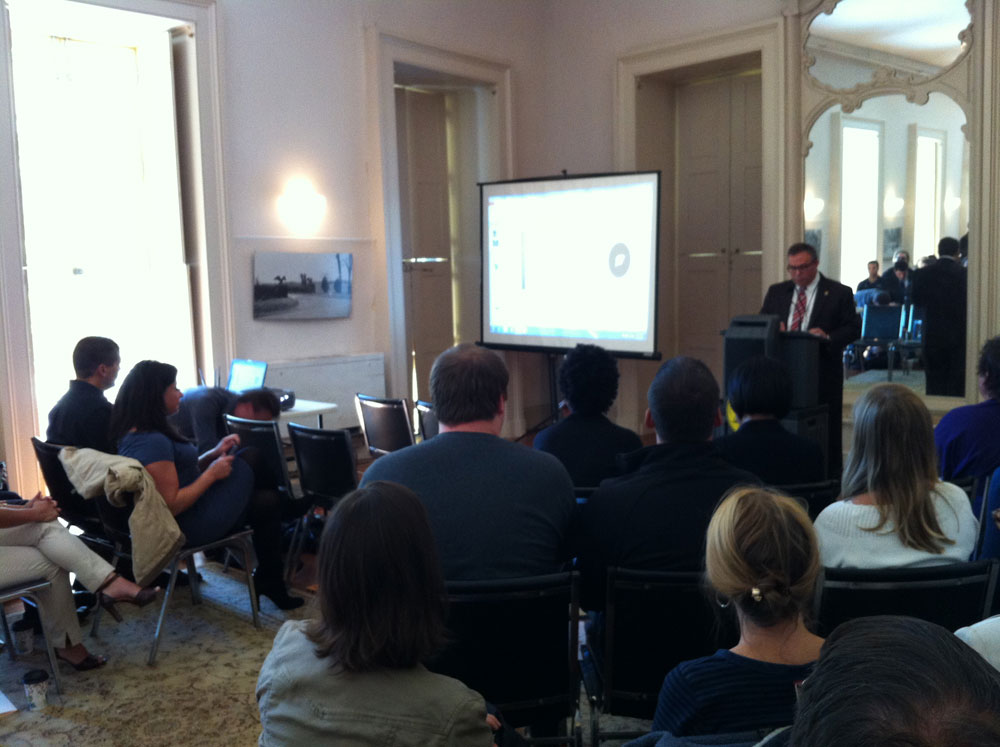Hack the Parks, Baltimore city’s first civic hacking competition, came to a close Tuesday morning as five different low- and high-tech ideas for preserving and improving the city’s parks were presented to the Department of Recreation and Parks, city CTO Chris Tonjes and Mayor Stephanie Rawlings-Blake.
“In Baltimore, we don’t have an underground tech community,” said Rawlings-Blake. “We have an integrated tech community.”
Projects included a map of the invasive vines in Gwynns Falls/Leakin Park and a public art project to paint a new set of 26 steel drum trashcans, which will be placed around Patterson Park in early October.
For a list of the five projects, skip to the bottom of this article.
The civic hacking competition was the culmination of almost a yearlong process, as well as a partnership between the city’s Department of Recreation and Parks, the Mayor’s Office of Information Technology (MOIT) and gb.tc. The idea for a civic apps contest was first announced in November 2012. Over several months, a firmer focus took shape, and Hack the Parks was formally announced in March as part of a broader civic hacking initiative called Hack Baltimore.
Watch city CIO Chris Tonjes and gb.tc’s Jason Hardebeck announce Hack Baltimore at Ignite Baltimore 12:
http://youtu.be/s0s88lyc1uw
MOIT contributed $10,000 in seed funding, which was distributed to six projects chosen from a stack of applications. (The sixth project, a virtual tour guide for city parks, wasn’t finished.) The five Hack the Parks teams that presented Tuesday morning piloted their respective “hacks” throughout the summer.
City officials extolled Hack the Parks as the first such hacking project in the country that used city money to bring the local government and the tech community together to work on park hacks.
“This is something surely to be recognized and implemented by other cities,” said CTO Tonjes.
Tonjes also said he’d like to do more civic hacking projects. And Mayor Rawlings-Blake, who left after delivering brief remarks and awarding city citations to the five teams, said she wants more interplay between city government and the tech community.
“I’m going to bring you out of wherever you all work [from] — Starbucks? — and into City Hall,” she said.
MOIT and gb.tc have additional funding to distribute to other civic hacking projects, which they plan on doing later this fall.
Hack the Parks projects:
- Mycosolve: Planting mushrooms to do mycology-based soil erosion control. A 20″ by 20″ test bed was planted in Druid Hill Park to determine if seeding native mushroom species (oyster and Shiitake among them) will prevent erosion and pollution from stormwater runoff.
- Mobile Maintenance Request System from Handteq: Startup Handteq developed an app for iOS, Android and the mobile web (for BlackBerry users) for Department of Rec and Parks superintendents and park managers to file maintenance requests via smartphone.
- Leakin Park Invasive Vine Control: Using a mobile app and GIS mapping, this team mapped the invasive vines in Gwynns Falls/Leakin Park. The Mayor’s Office of IT developed the mobile app, and the mapping showed that of roughly 1,200 acres of park land in Leakin Park, 72 acres are dead forest. Another 700 acres of trees are in danger of being choked off by vines.
- Hack the Trash: Spearheaded by the Fells Prospect Community Association and the Patterson Park Neighborhood Association, 26 steel drum trashcans were purchased and painted, and will be distributed to specific locations around Patterson Park in early October.
- BaltimoreTreeMap.org: A free online and mobile-responsive website to view and download data on where trees throughout the city are located. Users logged in to the site can add, edit and delete trees.







